
|
Sale 78
January Pre-Long Beach Sale 17.5% BP
| Seated Liberty Half Dollars |
| |
| |
| Lot |
Photo |
Description |
Realized |
Lot 1150 |
 |
1839. Drapery PCGS graded Genuine XF Details. Cleaning (PCGS # 6232) .
Estimated Value $60 - 70.
View details and enlarged photos
Check results on similar lots
| Realized
$235 |
Lot 1151 |
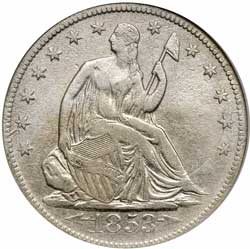 |
1853-O. Arrows and rays. NGC graded Shipwreck Effected (C) F. In a special box with certificate. Due to the reduction in the weight of the minor silver coins by the Mint Act of 1853, it became necessary to mark the new coins in some way to allow banks, etc., to distinguish them from the pre-Act silver of the old standard, some of which had been struck in 1853. In a letter to Mint engraver James Longacre on February 22, 1853, Mint Director Eckert discussed possible design changes to achieve this: ". One suggestion which has been made impresses me favorably; it is to make a change in the reverse of the half and quarter dollar assimilating them to the dime & half dime; that is introducing a wreath, with the name of the coin enclosed. Such alterations, in connection with arrows at the dates, as you have formerly proposed, might suffice ." Longacre replied on February 28: ". The time allowed by the law, is too short to warrant any elaborate revision or alteration of the present devices. I would therefore respectfully suggest the following changes, to be made on the obverse and reverse, respectively, of the silver coins now in use. On the obverse of the coins I propose to mark the place of the date, somewhat in the manner represented on the next page [that is, with facing arrow heads]. On the reverse, I propose for the half and quarter dollar to cover the space between the Eagle and the inscription with rays radiating from the centre of the piece -- or what in heraldic language is termed a 'glory' ." From this we can credit Longacre with the design changes on both sides of the coins.
Estimated Value $500 - 600.
Ex SS Republic.
View details and enlarged photos
| Realized
$447 |
Lot 1152 |
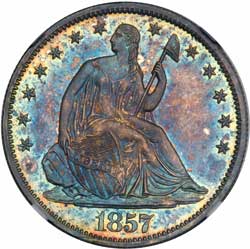 |
1857. NGC graded Proof 67. Gorgeous blue and golden toning. A nice boldly struck coin. The Phil Kaufman 1857 Proof half dollar, pedigreed to the John Work Garrett Collection (which incidentally is noted on the NGC insert), ranks in the top two or three of the 70 coins certified by NGC and PCGS.
For years numismatists have searched for records, but to this day, an unknown number of 1857 Proofs were struck. Randy Wiley and Bill Bugert, in their Liberty Seated Half Dollar reference, suggest that fewer than 15 pieces are known. Likewise, Walter Breen enumerates between 13 and 16 specimens in his Proof Encyclopedia. In light of the number of certified examples, the Wiley-Bugert and Breen numbers are probably on the low side, even with coins that are resubmitted to a grading service more than once. The Heritage sale cataloger of this piece wrote that "we have recorded at least 45 auction appearances of the 1857 Proof half in just the last 10 years. Of course, a number of these must have been reappearances. We estimate the surviving population is from 25 to 45 pieces."
The Kaufman 1857 Proof half dollar displays enchanting cobalt-blue, lavender, violet, and yellow-gold hues over both sides, with a shade or two deeper on the reverse. A respectable strike delivers bold definition to the design elements. Each side exhibits noticeable contrast between the frosted devices and reflective surface, especially when the coin is tipped back and forth under a direct light. One might expect this for the Superb Gem designation: the surfaces are impeccably well preserved. A coin for the ages! Pop 1; none finer at NGC .
Several events occurred in 1857 with important numismatic ramifications: The Act of February 21, 1857 was one of those Among other provisions, the half cent, coined intermittently since 1793, was eliminated, as was the large copper cent, minted since 1793. A new cent, of the Flying Eagle design, copied Gobrecht's bird from the dollar reverse of 1836-1839, was of reduced diameter, and was made of a new alloy consisting of 88% copper and 12% nickel weighing 72 grains. This alloy would continue in cents through early 1864, although the design would change to the Indian Head type in 1859.
On May 25, 1857, the new Flying Eagle cents were exchanged with the public for large cents, half cents, and worn Spanish-American silver coins. To facilitate this a temporary structure was set up in the yard of the Mint, where there were two windows, one marked CENTS FOR CENTS and the other CENTS FOR SILVER, to which coins could be brought and exchanged for cloth bags containing 500 cents ($5 worth).
Estimated Value $30,000 - 35,000.
Ex: Professor Anthon Collection, Part V (Cogan/Bangs, 10/1884), lot 239; John Work Garrett Collection; The Johns Hopkins University (Stack's 3/1976), lot 226.
From The Phil Kaufman Collection of Early Proof Sets, Part Four.
View details and enlarged photos
| Realized
$38,775 |
Lot 1153 |
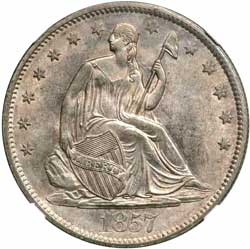 |
1857. NGC graded MS-64. A hint of gold tone. The border area with the stars show full strike on each, with equally impressive centers in the main devices. With the Congress adjusting the weight of silver coins per the Act of 1853, this allowed for sufficient coins in circulation for the first time since the 1830s. Alas, the plethora would cease almost at once when hoarding began in 1861. This time it was war that caused an acute small change shortage. Pop 24; 13 finer, 11 in 65, 2 in 66.
Estimated Value $1,500 - 1,600.
View details and enlarged photos
| Unsold |
Lot 1154 |
 |
1858. NGC graded Proof 64. Light gold and blue toning, deepest along the outer margin. Only 300 struck. Beginning with this issue, the mint offered Proofs to local coin collectors. Largely unsuccessful in its initial year policy, Proofs from 1858 are infrequently found nowadays because many were melted as unsold. This is a deeply reflective coin that has watery, non-contrasting surfaces with a few die polishing lines (as on many) and attractive patina. An important and hard to get hold of 1850s era Proof issue in very choice condition. Pop 10; 15 finer at NGC.
Estimated Value $2,800 - 3,000.
View details and enlarged photos
| Realized
$3,525 |
Lot 1155 |
 |
1862. PCGS graded Proof 64 Cameo. CAC Approved. Only 550 minted. A beautifulwhite Proof, cameo frosted on the main devices as well as the tops of the stars, date digits and legends. This frost against mirror field gives a coin its cameo contrast. The job was superbly done by the mint in 1862, as attested to here! Pop 16; 7 finer, 2 in 64+, 5 in 65 (PCGS # 86416) .
Estimated Value $3,000 - 3,200.
View details and enlarged photos
Check results on similar lots
| Realized
$4,348 |
Lot 1156 |
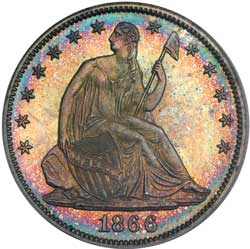 |
1866. With Motto. PCGS graded Proof 65 PQ. CAC Approved. Housed in an Old Green Holder. Only 725 struck. Lovely rainbow toning on both sides. One of the sections of the new law authorizing the switch to bronze in the Indian cent in 1864 permitted the Treasury to order the addition of the motto "In God We Trust" to any coin it thought proper. The beginning of the Civil War had prompted a great rise in religious feelings; an earlier suggestion in 1861 of adding the motto had found a receptive home in the Lincoln administration, especially with Treasury Secretary Salmon P. Chase. Several Pattern silver and gold coins had been struck during the war to illustrate the concept. In 1866, the Mint included the new motto for the first time on silver and gold business issues and the Proofs, such as this radiant Proof 65 1866 With Motto Seated Half Dollar. Pop 11; 5 finer in 66 (PCGS # 6424) .
Estimated Value $4,000 - 4,500.
View details and enlarged photos
Check results on similar lots
| Realized
$6,463 |
Lot 1157 |
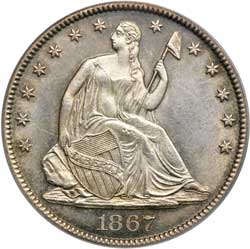 |
1867. PCGS graded MS-63. Well struck and mostly untoned. Semi reflective surfaces. A scarce business strike Half Dollar struck shortly after the American Civil War (or more properly, in the official U.S. government history, the War of the Rebellion). East of the Mississippi River, in the areas where the war was fought, most silver and gold was hoarded. A majority of new and old silver coins from 1861 to about 1875 were quickly exported to Canada and Central and South America, only to return in a flood (often well worn) in the final months of 1877, once monetary conditions stabilized! (PCGS # 6321) .
Estimated Value $700 - 750.
View details and enlarged photos
Check results on similar lots
| Realized
$1,293 |
Lot 1158 |
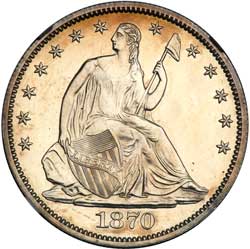 |
1870. NGC graded Proof 62. Mostly untoned. Razor-sharp devices. Only 1,000 struck.
Estimated Value $650 - 700.
View details and enlarged photos
| Realized
$823 |
Lot 1159 |
 |
1873. No arrows, closed 3. NGC graded Proof 67 Cameo. Well struck with lovely blue and golden toning. Only 600 Proofs were struck, few of which enjoy both a high nominal grade and pleasing cameo contrast. This specimen exhibits an excellent strike and wonderful cameo contrast. Light magenta toning covers the centers, which are framed by a narrow band of turquoise. The surfaces are impeccably preserved, displaying no significant marks. Pop 1; 2 finer, 1 in 67 Star, 1 in 68 Star.
Estimated Value $6,000 - 7,000.
Previously in Heritage's December 2005 sale.
View details and enlarged photos
| Realized
$12,338 |
Lot 1160 |
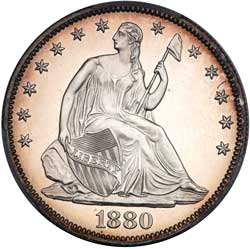 |
1880. PCGS graded Proof 64 Cameo PQ. CAC Approved. A hint of light gold tone. The seated Liberty dates 1879 to 1889 are very popular due to their low mintage. Only 1,355 Proofs minted. Pop 22; 50 finer, 2 in 64+, 33 in 65, 14 in 66, 1 in 66+ (PCGS # 86441) .
Estimated Value $1,500 - 1,600.
View details and enlarged photos
Check results on similar lots
| Realized
$2,115 |
Lot 1161 |
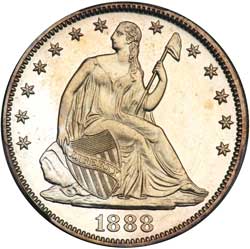 |
1888. PCGS graded Proof 62 Cameo. A nice white coin. Only 800 struck. Pop 4; 38 finer at PCGS. (PCGS # 86449) .
Estimated Value $750 - 800.
View details and enlarged photos
Check results on similar lots
| Realized
$952 |
Lot 1162 |
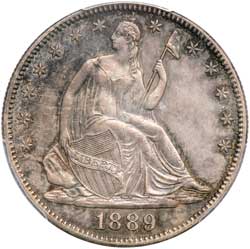 |
1889. PCGS graded MS-64. Only 12,000 minted. Nice old time toning. Dates from 1879 to 1889/90 are low mintage. Some have pointed to the Mints busying themselves striking silver dollars. But another and possibly chief cause of the declining need for Dimes, Quarter Dollars, and Half Dollars in particular in those years was the reappearance of a flood of "old tenor" silver of the Civil War period into the country. The inflow started in late 1877. By the mid-1880s, the Treasury Department's vaults were virtually overflowing with excess bags of coins. Too many for commercial interests to use. Pop 48; 32 finer, 1 in 64+, 19 in 65, 1 in 65+, 11 in 66 (PCGS # 6371) .
Estimated Value $1,250 - 1,300.
View details and enlarged photos
Check results on similar lots
| Unsold |
|
|